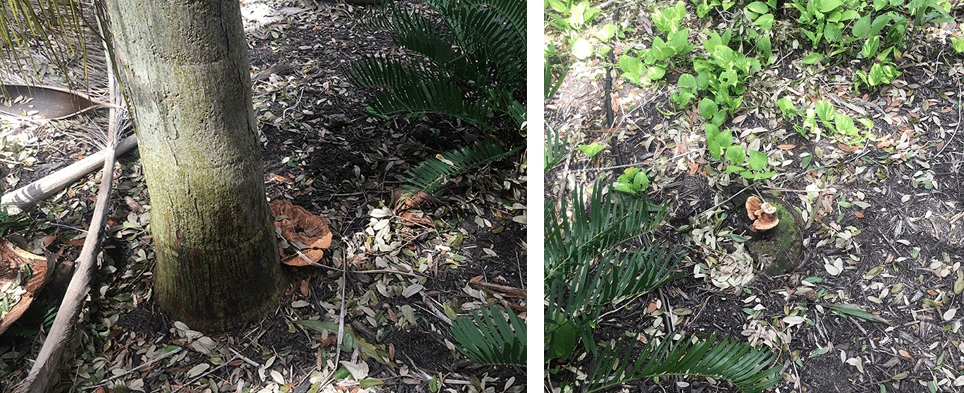Ganoderma Palm Disease
Can You identify this palm disease in the landscape. Once a Palm is dead and cut down it’s extremely important to remove the stump or grind the stump to eliminate any other palms from contamination.

This palm disease is extremely dangerous to any palm, it spreads easily through pruning shears or chainsaws and there are no current treatments for this disease. The hard, Brown mushrooms are the fruit from the disease and should be carefully removed then immediately disposed of in the trash.
The unique shape and rich textures of Palm Trees have become a symbol of the Florida lifestyle and their durability and adaptability have made them a favorite of landscape designers in the warmer parts of the state, but these hearty plants can succumb to a variety of diseases including Ganoderma.
Ganoderma zonatum, the pathogen that causes Ganoderma Palm Disease, was first identified by scientists at the University of Florida’s Fort Lauderdale Research and Education Center in 1994. This lethal and incurable disease which affects mature palms can easily spread through pruning shears or chainsaws and it is important to remove or grind the stump, once a tree has been cut down.
In the early stages of Ganoderma Palm Disease, the older fronds droop and turn brown, and new growth slows and becomes pale green or yellow. As the older fronds continue to die, the younger leaves begin to wilt and turn brown at the tips. Infected trees will usually die 6 to 12 months after the initial symptoms appear. Some trees have been known to hang on for several years, but they should be removed once the disease is identified in order to prevent further contamination.
Other symptoms include “bleeding”, a reddish secretion that stains the trunk, and the formation of a conk or bracket fungus on the lower part of the trunk as seen in these photos. This conk is the reproductive body or fruit of the disease and it should be carefully removed and immediately disposed of to protect neighboring palms. The presence of this hard, brown mushroom is proof that the tree has Ganoderma, but the absence of the same does not mean that a palm may not be infected.
The fungus starts out as a small, white blob that is flat against the tree. As it grows, it begins to jut out like a shelf, its texture becomes woody, and its color changes to a shiny brown with bands of reddish and lighter shades of brown. At maturity, the conks swell around the edges revealing a white surface where millions of spores are produced. These spores are then transported to other palms by the wind.
You should avoid replacing the removed palm with another palm because any fungus still present in the soil or root system of the diseased palm could infect the new palm. If you do are set on another palm, you should remove all of the old roots and replace the soil with new soil, but your best bet is to plant something other than a palm tree in that spot.
If you see the telltale conk or otherwise suspect that your palms have become infected with Ganoderma and you are in Siesta Key, Longboat Key, Lido Key or the surrounding areas of Sarasota County, call Siesta Key Landscape at 941-379-3479.








